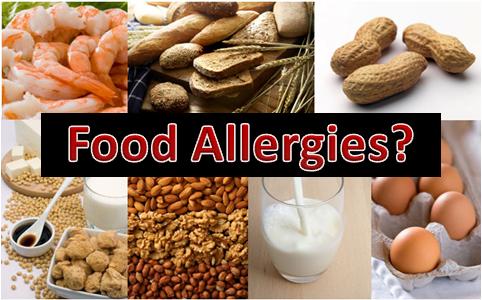
Food allergies are due to IgE antibodies made for specific foods that an individual has for some reason developed because their body has misinterpreted the food(s) as a foreign invading protein. The presence of IgE antibody to the specific food a person is allergic to results in an immediate immune reaction of the body to the food when it is eaten. The IgE antibody binds its specific food protein and initiates reactions in the body that include the release of chemicals such as histamine that may result in symptoms of itching, swelling, wheezing or difficulty breathing, rash or hives, and if severe, shock resulting in death if not reversed. Vomiting and diarrhea may occur but are less common.
Testing for the presence of allergy to a food or foods can be done by blood test or skin testing or both. One of the most common blood tests is the RAST test that looks for the presence of the specific IgE antibodies to common food allergens and other foods based on a history suggesting that a particular food is suspect. Skin testing is done by injecting or applying extracts of the common and any suspect food(s) to pricked or scratched skin and looking for diagnostic "hive" like reactions at the site of the suspect food. The most common food allergens are peanut, cow's milk, wheat, corn, soy, shellfish, eggs, tree nuts, chocolate, pork, tomato, and citrus.
The terms food intolerance and sensitivity are commonly used interchangeably. They refer to a group of food reactions that occur that are not IgE antibody caused. In more general terms they refer to any adverse or unpleasant reaction that occurs after a food is eaten.
Food reactions that are not allergic in cause may have a variety of causes. A particular food may not be tolerated because it is not digested adequately due to an enzyme deficiency. Lactase, the enzyme that digests milk sugar or lactose, is present on the surface of the intestine lining cells. Lactase deficiency can be inherited or acquired. It commonly occurs whenever the intestine lining is damaged. Because the lactase enzymes are on the outer most surface of the intestine they are more vulnerable to injury. For example, after intestinal flu or in untreated Celiac disease, lactose intolerance is common. Other sugar enzymes can be deficient or the intestine can be simply overwhelmed by too large a sugar load at one time. A classic example is "the Big Gulp" syndrome when someone drinks a giant cola beverage then experiences the "gut ache" from the tremendous amount of fructose. Large amounts cannot be handled by the intestine and that results in bloating, urgency and terrible diarrhea.
Deficiency of digestive enzymes released into the intestine can result in poor digestion of foods. For example, when the pancreas gland is damaged (pancreatitis) chronically, usually from chronic alcohol abuse, or is congenitally underdeveloped or malfunctioning (e.g. cystic fibrosis). The pancreatic enzyme deficiency that occurs results in malabsorption, especially for fats, that cause symptoms of diarrhea and weight loss. Abnormal bacteria types and levels in the gut, also known as dysbiosis, and abnormal excess levels of "bad" bacteria or presence of bacteria in upper small intestine where little or no bacteria normally occur (bacterial overgrowth) can interfere with digestion, absorption or cause fermentation of food resulting in symptoms of abdominal pain, bloating, gas, and diarrhea.
Some foods and food additives have a direct toxic effect on the gastrointestinal tract. Additives such as MSG and sulfites can cause symptoms, including flushing and diarrhea or the "Chinese restaurant" or "salad bar" syndromes.
All foods contain proteins known as lectins. Some of these proteins are highly resistant to digestion and are toxic to the human intestine especially if they are not pre-treated by soaking, cooking well, or removing toxic portions. For example, inadequately soaked and cooked kidney beans will cause a food poisoning like illness. There are several foods that have lectins that are poorly tolerated by many humans and are lethal to insects and pests. One researcher, Loren Cordain PhD., author of the Paleo Diet, has published extensive research on how the human intestine is not "evolved" to tolerate many of the foods we now eat but did not eat in the ancient "hunter-gatherer" times resulting in many of the illness seen in modern societies and the rising epidemic of autoimmune diseases. Several of the "modern" foods that were not part of the ancient diet but constitute much our diet now have well recognized toxic or poorly tolerated proteins known as lectins. Examples include wheat germ agglutinin (WGA), casein (cow's milk protein), peanut agglutinin (PNA), soyabean agglutinin (SBA) and tomato lectin (TL) that have been shown in animal studies to be toxic to the human gut. There are a few published studies and little active research on the role of dietary lectins in health and disease.
When the reaction is an immune toxicity reaction to a food protein intestinal damage commonly results, frequently referred to as "leaky gut" because of the symptoms of malabsorption or the entry of toxic food proteins and/or bacterial products into the blood stream resulting in a variety of adverse health effects. This reaction may result in autoimmunity, the body attacking itself within the gut or distant organs or tissues. The reaction may be aided by abnormal bacteria types and/or levels in the gut (dysbiosis). The symptoms commonly develop over time and flare in just hours to up to three days after eating the offending food and continue as the food is eaten.
Because the protein in the food is usually the cause and such proteins may be hidden in other foods, especially processed foods, and the toxicity is more of a delayed and cumulative immune reaction, it is very difficult for the person suffering from this to identify the specific food as the cause. For example gluten (the protein in wheat) and casein (the protein in cow's milk) are in many foods and toxic to many individuals. Over time people sensitive to such food proteins typically become more ill and may develop enough intestinal injury that blood tests for other types of antibodies, IgG and/or IgA, to the food or specific food proteins, may be detectable in the blood, stool or saliva.
Delayed immune response to proteins in the food (wheat, cow's milk) resulting in bowel injury, gastrointestinal and non-gastrointestinal symptoms and increased autoimmune conditions is most well recognized in Celiac disease. It is an autoimmune disease resulting from ingestion of gluten in wheat or products made from wheat flour (or gluten like proteins in barley and rye). It used to be considered a disease of children and rare, especially in the United States. However, blood test screening studies have documented that it is present in approximately 1 in 133 to 1 in100 people worldwide though most of those affected are undiagnosed and untreated. It is diagnosed by positive screening blood tests and confirmed by a characteristic abnormal small intestine on biopsy followed by relief of symptoms and return of the intestine to normal after a gluten-free diet. Untreated it is associated with higher rates of cancer especially lymphoma, osteoporosis, anemia, and other complications of malabsorption resulting in shortened life expectancy. It is treated with a life-long gluten free-diet. Lesser degrees of gluten intolerance or sensitivity may not be severe enough to cause abnormal or diagnostic blood tests and intestinal biopsies but result in symptoms that improve or resolve with a gluten-free diet and may be detected by elevated stool or saliva antibody tests.
Though injury to the intestine tissue may be seen visually as abnormal appearing tissue during endoscopic procedures such findings are non-specific for the cause. The tissue frequently appears normal and therefore many times is not sampled by biopsy, though under the microscope injury may be seen, though not specific for cause or food. If the physician is either not suspecting food intolerance or doesn't routinely biopsy normal appearing intestinal tissue looking for signs of food intolerance, the injury may not be discovered.
The immune based food intolerances are commonly associated with many symptoms that can be both gastrointestinal and outside the gut and may include bloating, gas, diarrhea (and sometimes constipation), abdominal pain, nausea, fatigue, headaches, joint and muscle pains, skin rashes, weight loss or gain, anemia or nutritional deficiencies, irritability, depression, mental fogginess, and nerve pain (neuropathy). These symptoms may be misdiagnosed or mislabeled as irritable bowel syndrome, chronic fatigue syndrome, reflux, ulcer, and fibromyalgia, etc. without another thought by patient or physician that food intolerance may be the cause and specific food elimination may be the cure. The common food allergens also are the most common causes of food intolerance reactions.
Generally, most physician are aware of common food allergy symptoms and how and when to test. However, several studies have confirmed most people's experience that the majority of primary care physicians are unaware of the common symptoms of Celiac disease, that blood tests exist for screening antibodies and the high risk genes, and that it is common and may be diagnosed in adults. This is why the diagnosis is delayed on average over 11 years in most adults, after many of them have irreversible complications such as osteoporosis, cancer, or another autoimmune disease. The awareness and acceptance of non-Celiac gluten sensitivity and other food protein intolerances in the medical community is even worse.
Therefore, food intolerance or sensitivity is commonly missed and untreated. Many patients are forced to self-diagnose by discovery of the link of their symptoms to specific foods serendipitously, often as a result of an elimination diet, recommendation of an alternative practitioner or friend/relative, or search for help on the internet or multiple physicians for help. Hopefully, by reading this article you now better understand food allergies and intolerances, why they are often missed and that they are a common cause of many symptoms, not just intestinal, that usually improve if not resolve once the offending food or foods are eliminated from your diet.






